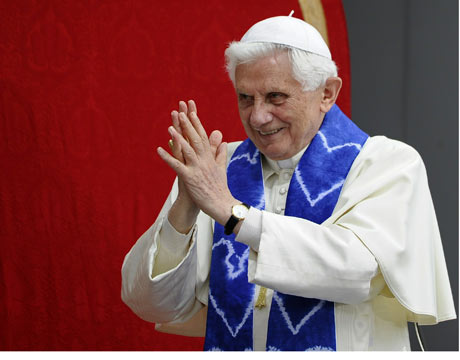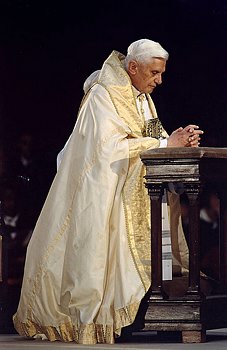shiv wrote:The Roman toga is more likely connected with this Indian attire

Yep, this is quite straight-forward. This is likely related to the following style:
Draping the uttariya around the body with or without covering the head:

This also possibly explains why Jesus is portrayed in an uttariya or toga draped around shoulders. So, he is simply shown in a roman attire. Though, I am curious whether christians would be hurt if Jesus is depicted in a suit and tie.
Interestingly, christian pope and other churchmen seem to wear a piece of cloth hanging from their neck (with no knot).
Uttariya around the neck(without the knot):

Uttariya around the shoulders:

Note, the typical Indian style of borders on the above robe that he has draped.
Intriguingly, the christian pope doesn't seem to wear a tie.
----
The one famous ancient Indian icon that is portrayed wearing the uttariya in the same manner as the depiction of Jesus is: Buddha.

This is another datapoint in favour of Jesus being a crypto-buddhist fictional figure. In Indian context, Buddha is the only ancient religious icon that is represented with uttariya draped around his shoulders without covering the head(the same manner in which Jesus is depicted). Mahavira is generally portrayed as naked. Hindu Gods are shown wearing the uttariya in a more stylish manner. So, there are not only conformity in tales of Buddha and Jesus but also in their attires.
Generally, Hindu Gods are not portrayed in the toga style of uttariya. It is more stylishly draped:

However, the regular Hindus wear uttariya in various styles(including toga style).
---
So, roman/greek toga may be a direct descendent of one style of wearing uttariya. While, tie may be a transformation of the following style of wearing uttariya:
c) Wearing the uttariya around the neck:

In this style, it is not uncommon to tie the two loose ends of uttariya into a knot around the neck for the sake of convenience, so that the uttariya does not fall off. This style may have transformed into a tie.
Virupaksha wrote:Tie is a torture to wear. I would be grateful if it originated in some dumb ass country.
It is indeed torturous to wear any cloth around the neck. It seems, in recent times, more and more people don't want to wear a tie unless it is an official requirement.
I think this is an important pointer. Because, the reaction of the earlier times would have been similar. People would have stopped using tie especially once it stopped having any use. Yet, tie continued to be used, even though it served no purpose.
If one assumes that tie was invented(and intended) for a purpose 'X', then tie would have gone out of fashion, once the 'X' became irrelevant. But that has not happened. So, the rational conclusion is that even though the tie may have been used for 'X', it was not intended or invented for only that purpose. I mean co-relation is not equal to cause.
So, all of the below points may be true. I mean, tie may have been used to serve all of the following purposes and more. But, was it invented for these purposes?
If you are going to wear a piece of cloth around your neck, you may as well use it to keep your neck warm, or fasten your shirt more tightly, or hide the dirt marks on your shirt, or use it to save the shirt from food droppings, or distinguish yourself from others by wearing it specially, or wipe the sweat off the brow, so on and so forth. In short, you can use it in variety of ways according to your needs. But, the question is whether is was intended(and invented) for this purpose?
All of these seem like a very trivial reason to introduce a new and long-lasting change in an attire, especially since those purposes can be more easily and effectively served by other means than a tie.
matrimc wrote:I may be wrong, but I thought a tie is worn to stop cold air reaching one's skin.
I presumed the same sometime back:
But:
a) women's clothing doesn't seem to have any corresponding feature to keep the cold out. Some women's clothing did have cloths around the neck, but it seems more of a style statement than otherwise. Women wore shawls around their shoulders which is a far more effective way to stop the cold.
b) people from other cold regions(like Eskimos) don't seem to have this feature(cloth around their necks).
c) there are more effective ways to stop the cold than a tie. Some of the ties are useless against the cold.
I am not saying that tie was not used for keeping the neck warm. I am saying that it may not be the reason for its invention and that may not be its primary use.
Abhibhushan wrote:JohneeG wrote:
Is it possible that 'tie' was imported from India?
I remember being taught in my childhood that in the old Roman Empire the subjugated people were required to wear a piece of rope around their neck and the neck tie is a derivative of that old custom in the British Isle!
I don't know if this happened, but lets assume this did happen. Would those people continue to wear what were symbols of their subjugation? Would such changes in attire survive for such a long time?
Seems a bit difficult to swallow that such a change in attire can survive for such a long time despite it having no productive use. I am not saying that it is not possible to use ties to distinguish people(by the social rank). It is very much possible. I think the longevity is an indicator that perhaps the ties were already part of the attire and that they were changed to indicate the new social rank.
A_Gupta wrote:The tie comes from when buttons and other fasteners were expensive, this was a way to secure the top of your shirt.
There are 2 possibilities:
1) top of the shirt is the only place where a shirt could be secured. And for this one place, people resorted to using clothes instead of very expensive fasteners or buttons.
2) rest of the shirt had other fasteners or buttons, while the top of the shirt was secured with a cloth around the neck.
In case (1), buying a single fastener would be enough. In case (2), one is already buying other fasteners or buttons, so one more extra fastener or button has to be bought for the top of the shirt. Also, securing the top of the shirt is not a compulsory. So, if one does not have a fastener to secure it, one would leave it open, instead of spoiling the look with a cloth around the neck.
Moreover, the tie seems to be taken as a sign of culture and people of high rank seem to have practiced it more diligently than the masses. So, this explanation does not work.
ramana wrote:JhoneeG, The modern tie is a short version of the caravat or the bandana. It was worn to save the shirt from food drippings like runny soup.
Any good book on western costume would tell us about the evolution of the tie.
Ramana garu,
this reason seems a tad silly. Because, if that was the only purpose, then one would wear it only during meals. Why would one wear it all the time? For example, some people also place napkins on their lap while eating. But, they don't tie a napkin around their waist all the time, do they?
Also, if the tie was full of food drippings, then it would make sense to remove it after the meal and show the clean shirt to others instead of continuing to sport that dirty tie around the neck concealing the clean shirt. Infact, it defeats the purpose of keeping the shirt clean if that shirt is covered by the cloth which is covered in food drippings.
Anyway, it is interesting that wiki offers another 'origin' story for tie tied to another event:
The modern necktie taken up, then spread by, Western Europe traces back to the time of Thirty Years' War (1618–1648) when Croatian mercenaries from the Croatian Military Frontier in French service, wearing their traditional small, knotted neckerchiefs, aroused the interest of the Parisians. Due to the slight difference between the Croatian word for Croats, Hrvati, and the French word, Croates, the garment gained the name "cravat".[1] The new article of clothing started a fashion craze in Europe where both men and women wore pieces of fabric around their necks.
All that may well have happened. But, the point to note is that these croatians were only following their general routine, not inventing anything new. So, the same question gets repeated, why so they wear a kerchief around their necks? Whats the context? Is there a context? I don't think there is any context. Also, are we sure that others(including europeans) were not wearing similar neck clothing before this event?
In fact, there seems to be a long history of neck clothing along with draping the clothing around the shoulders(2 ways of wearing uttariya) before and after this croatian incident.
For example, in Rome:
a) A general wearing a toga or uttariya around the shoulders:

(This may be the inspiration for the cape around the nape of the neck of western cartoon superheroes like Superman. That means, Superman also wears the uttariya.

)
b) Pictures of Roman soldiers from approximately 100 B.C. show them wearing neck cloths:

So, the same culture has two variations of uttariya.
---
In china:
The Qin Emperor’s Terracotta Warriors wore silk cords around their necks as signs of their elite status(221 to 206 BC):

----
In Europe:
different style of neckclothing:
2 images:
http://upload.wikimedia.org/wikipedia/c ... a-1818.gif
http://beehivestudio.typepad.com/Blog_I ... Ties13.jpg

















